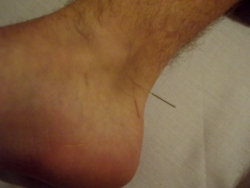Research in Japan shows acupuncture is associated with clinically relevant improvements in shortness of breath on exertion, in patients with chronic obstructive pulmonary disease (COPD).
A total of 68 patients with COPD were randomised to receive either acupuncture, or non-penetrating placebo acupuncture, in both cases in addition to usual care. Treatment was spread over 12 weeks, following which breathlessness scores after a six minute walk, were significantly better in the real acupuncture group compared with the placebo group. In addition though, patients in the real acupuncture group showed clinically relevant improvements in nutritional status, body-mass index, airflow obstruction, exercise capacity, and health-related quality of life; no such improvements were exhibited by the placebo group.
This research has been described as thoughtful and methodologically rigorous, and the team include some speculative ideas on how acupuncture may be able to help COPD patients by relaxing hyper-activated respiratory muscles.
(A Randomised, Placebo-Controlled Trial of Acupuncture in Patients with Chronic Obstructive Pulmonary Disease (COPD): The COPD-Acupuncture Trial. Archives of Internal Medicine, June 2012.)



